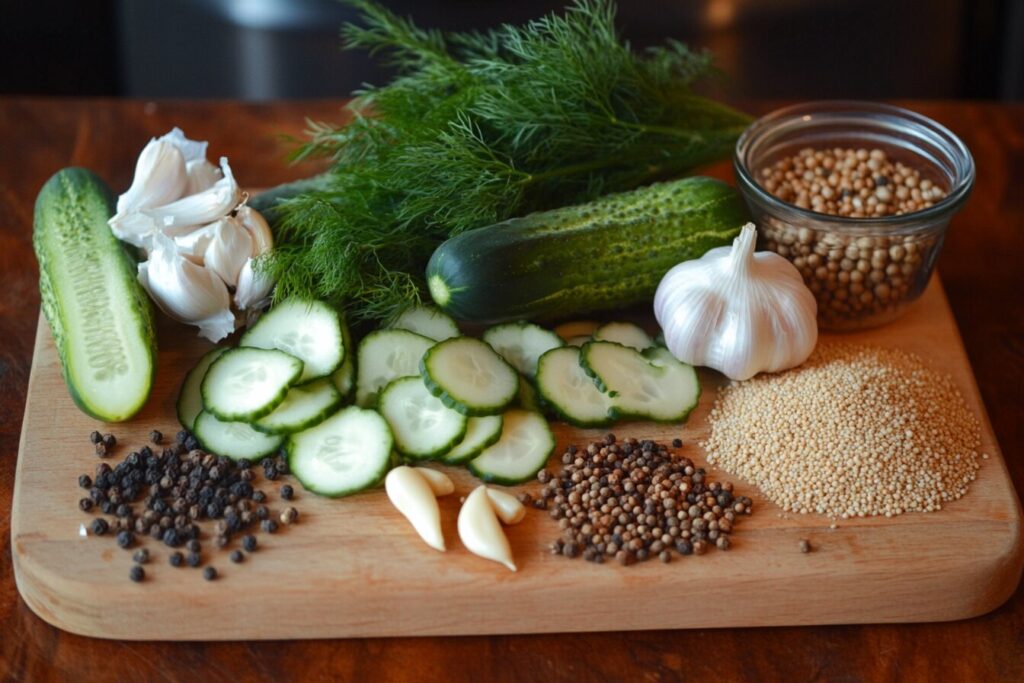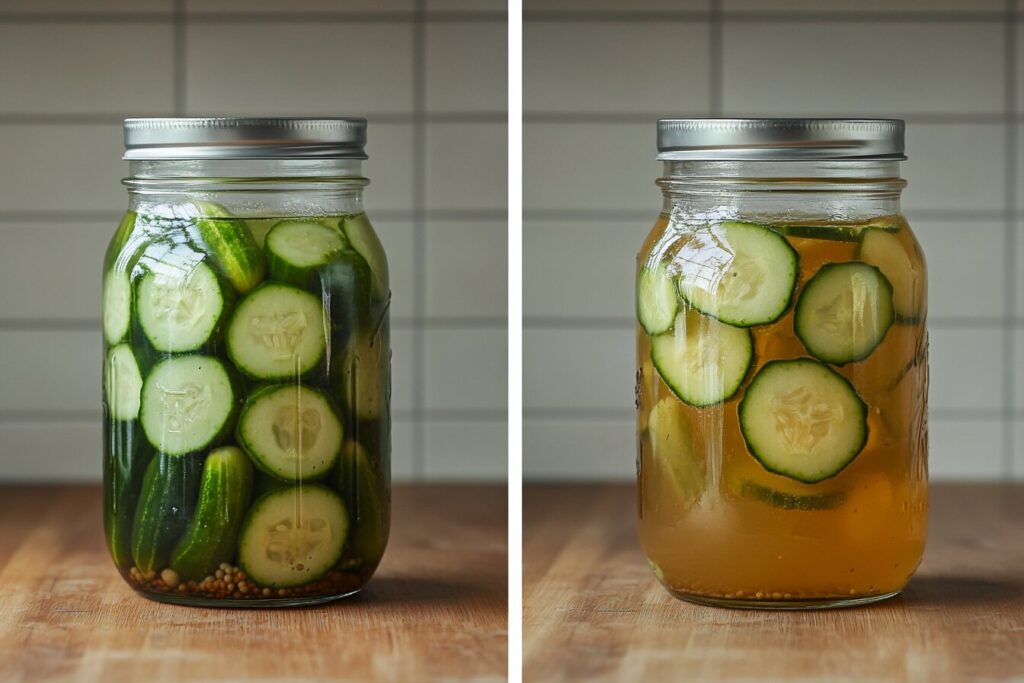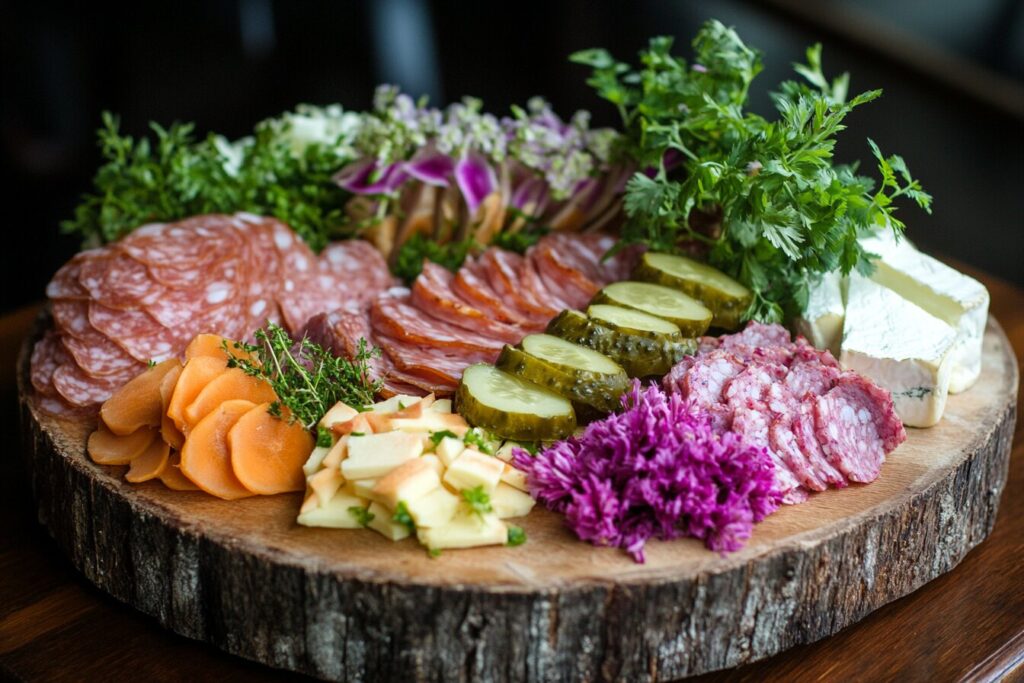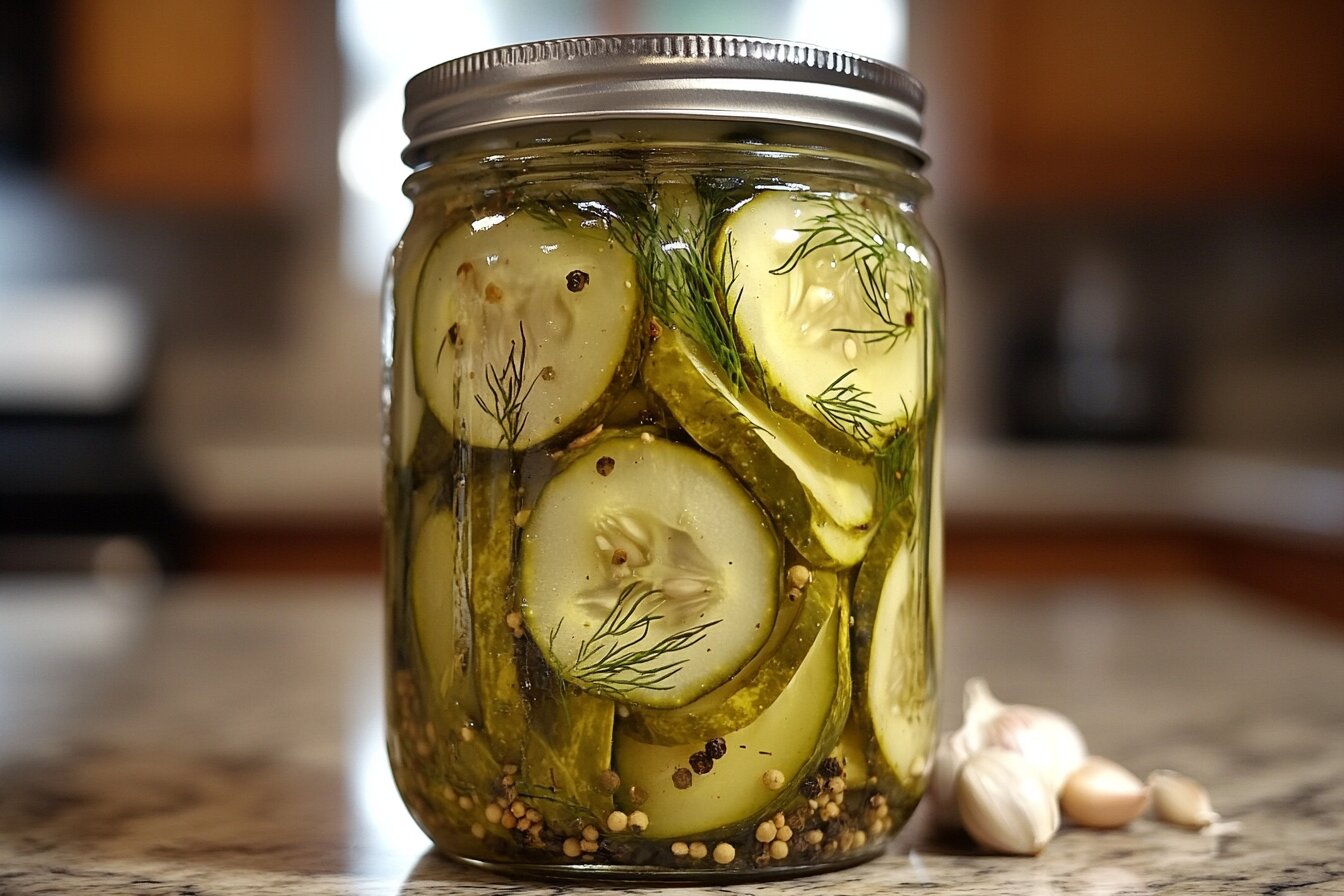Homemade pickles are becoming more popular, especially among food lovers. Making a kosher pickle at home is a special treat. This guide will help you learn how to make this classic American pickle in your kitchen.
With a long history and many styles, knowing the right methods and ingredients is key. As you start making kosher pickles, you’ll enjoy the process. You’ll also connect with a beloved tradition.
Key Takeaways
- The significance of kosher pickles in American cuisine.
- An overview of the essential ingredients for homemade pickles.
- Understanding the different pickling methods available.
- Common mistakes to avoid during the pickling process.
- Storage tips for maintaining the freshness of kosher pickles.
- Variations of kosher pickles to explore.
- Serving suggestions that enhance the enjoyment of pickles.
Introduction to the Classic Kosher Pickle
Kosher pickles are a big deal in the world of food, especially in Jewish cuisine. The word “kosher” means they follow certain food laws. This makes them special, with a flavor that’s all their own.
These pickles are more than just a side dish. They’re a way to connect with heritage and community. They’re loved by many, not just in Jewish homes but all over the U.S. Their unique taste and preparation are a nod to old recipes passed down through families.
“Kosher pickles are a celebration of flavors that connect us to our roots and invite everyone to share in the experience.”
Kosher pickles are now loved by many for their crunchy texture and rich taste. They’ve become a key part of both Jewish food and the wider food world. This lets people from all walks of life enjoy this tasty treat.
The Rich History of Kosher Pickles
Pickling has been around for thousands of years, helping people keep food fresh. The *kosher pickle origins* come from Eastern European Jewish communities. They used brining to make vegetables last longer and add unique flavors.
Jewish pickling traditions have shaped kosher pickles in America. Immigrants brought their old ways to the New World. In cities like New York, deli culture grew, showing the link between Jewish food and pickles.
Over time, pickling has changed, but Jewish traditions stay strong. The use of spices and following kosher laws show how important pickles are in Jewish life. Every jar holds a story, connecting past and present.
Key Ingredients for the Best Kosher Pickle
Making great kosher pickles starts with picking the right ingredients. The type of cucumber and spices used greatly affect the taste and feel. We’ll explore the best cucumbers for pickling and the spices that make pickles special.
Types of Cucumbers Used
For the best kosher pickles, certain cucumbers are better than others. Kirby cucumbers are a top choice because of their firm texture and crispness. Their size helps them stay crunchy during pickling.
When picking cucumbers, look for:
- Freshness: Firm and bright green cucumbers are of high quality.
- Size: Small to medium-sized Kirby cucumbers make the best pickles.
Spices and Seasonings
Spices play a big role in the taste of kosher pickles. Garlic and dill are key ingredients for authentic flavors. Garlic adds a strong taste, while dill brings a fresh herbal flavor.
Other spices to add to your brine include:
- Mustard seeds
- Black peppercorns
It’s also important to get the salt right in the brine. The right mix of spices turns cucumbers into tasty kosher pickles.
| Cucumber Type | Texture | Ideal Size |
|---|---|---|
| Kirby Cucumbers | Crisp and Firm | Small to Medium |
| English Cucumbers | Smooth, Less Crunch | Medium to Large |
| Persian Cucumbers | Crisp with Thin Skin | Small |

Choosing the Best Method for Kosher Pickle
Choosing the right pickling method is key to the taste and texture of kosher pickles. There are two main methods: fermentation and quick pickling. Each has its own benefits, making them perfect for different tastes and needs.
Fermentation vs. Quick Pickling
Fermentation pickles use natural bacteria to turn cucumbers into tangy treats. This process takes time, as pickles ferment for days or weeks. The flavor grows slowly, creating a rich taste that many love.
Quick pickles, on the other hand, are quick and easy. They soak in a vinegar brine, ready in hours or days. Quick pickles offer a fast, sharp flavor, perfect for those in a hurry. Though they might not have the depth of fermentation, they still offer a nice crunch and taste.
| Pickling Method | Flavor Profile | Texture | Preparation Time |
|---|---|---|---|
| Fermentation | Complex, tangy | Crisp but tender | Days to weeks |
| Quick Pickling | Sharp, immediate | Crunchy | Hours to few days |
Knowing the differences between pickling methods helps in making the right choice for kosher pickles. Your taste, time, and flavor preferences will guide you between fermentation and quick pickles.

Step-by-Step Kosher Pickle Recipe Guide
Making kosher pickles requires careful steps to prepare and flavor cucumbers perfectly. This guide covers each step, from preparing cucumbers to jar packing techniques.
Preparing the Cucumbers
The first step is to clean the cucumbers well. Start by washing them under cold water to remove dirt and wax. Then, cut off the stem ends to help them soak up the brine better.
Creating the Pickling Brine
Creating a tasty pickling brine is key. Use a mix of vinegar and salt to flavor and preserve the cucumbers. A good base is equal parts water and vinegar, with salt to taste. Try different vinegars like apple cider or white wine for unique flavors.
Packing the Jars
Properly packing jars is crucial for kosher pickles. Sterilize the jars first. Then, pack the cucumbers tightly to avoid air pockets. Pour the brine slowly to cover the cucumbers and seal the jar. This method ensures great flavor and longer shelf life.
| Step | Details |
|---|---|
| Cucumber Preparation | Wash cucumbers thoroughly and trim the ends. |
| Pickling Brine | Combine vinegar, water, and salt in the appropriate ratio. |
| Jar Packing | Sterilize jars, pack cucumbers tightly, and pour in brine. |
Avoiding Common Kosher Pickle Mistakes
Making kosher pickles can be rewarding, but some mistakes can ruin the taste. Knowing these mistakes helps make better pickles every time.
Over-packing Jars
One big mistake is packing jars too full. This blocks the brining process. It’s important to leave enough space for brine and ingredients to expand.
This space helps flavors spread evenly. Try to pack cucumbers tightly but not too hard. This keeps their texture and taste good.
Ignoring Temperature Control
Temperature control is key during pickling. Wrong temperatures can ruin the batch. Keep jars in a cool, stable place for best results.
Too hot can cause bad flavors or spoilage. Too cold slows down fermentation. Aim for a moderate temperature for great pickles.
Tips for Storing Kosher Pickle for Freshness
Storing pickles right is key to keeping them fresh. Knowing how to cool them down and using the right storage tips can make a big difference. This way, your pickles will stay tasty and safe to eat for a long time.
Understanding the Cooldown Period
It’s important to let the jars cool down slowly after pickling. This helps prevent them from bursting and keeps the flavors and textures better. If pickles cool down too fast in the fridge, they might break.
To cool them down right, let the jars sit at room temperature for a few hours before putting them in the fridge.
Best Practices for Storage
Storing pickles the right way can really help them last longer and taste better. Here are some top tips for storing pickles:
- Keep them in a cool, dark spot. Light can make the pickles go bad faster.
- Stay away from hot places. Heat can cause pickles to spoil quicker.
- Use containers that don’t let air in. Make sure the lids are tight to keep out moisture and germs.
The shelf life of pickles depends on a few things. Usually, kosher pickles can last from 1 to 3 months in the fridge. But if you store them in a pantry, they might not last as long. By following these storage tips, you can keep your pickles fresh for a longer time.
Exciting Variations of Kosher Pickle to Try
Kosher pickles are a favorite for many. Trying different flavors can make them even better. You can add a spicy kick or a sweet touch. Here are two ways to enjoy kosher pickles in new ways.
Spicy Kosher Dill Pickles
Spicy kosher pickles are great for those who like a little heat. You can add red pepper flakes or jalapeños to the mix. To make spicy pickles, just change the brine to get the right heat.
- Start with a basic dill pickle brine.
- Add 1-2 teaspoons of red pepper flakes or chopped jalapeños.
- Experiment with the amount to tailor the spice to personal taste.
- Allow the pickles to sit for a week for the flavors to meld.
Sweet Kosher Pickles
Sweet kosher pickles are a nice change from spicy ones. They get their sweetness from sugar or other sweeteners. A simple sweet pickle recipe can add a nice crunch to any meal.
- Utilize the same basic dill pickle brine.
- Add 1 cup of sugar or honey to the mixture.
- Adjust sweetness according to preference for a personalized flavor profile.
- Let the pickles infuse for at least three days to develop a rich flavor.
These variations not only change the taste but also make pickling fun. Try these recipes and find a new favorite way to enjoy kosher pickles.
Delicious Pairings for Kosher Pickle
Kosher pickles add a delightful crunch and burst of flavor to many dishes. They are great with a variety of foods, making meals more enjoyable. Here are some top ideas for pairing kosher pickles with other foods.
Foods That Complement Kosher Pickle
Pairing kosher pickles with the right dishes can really make a meal better. Here are some popular choices:
- Sandwiches: Kosher pickles are perfect with sandwiches. They add a tangy crunch that balances the richness of meats like pastrami or corned beef.
- Charcuterie Boards: Adding kosher pickles to charcuterie boards adds a new flavor layer. They complement meats, cheeses, and crackers well.
- Potato Salads: Adding diced kosher pickles to potato salad gives it a zesty twist. It adds acidity and bite to the dish.
- Salads: Chopped pickles can refresh green salads. They add texture and zing.
- Burgers: Kosher pickles on burgers add flavor and crunch. They enhance the burger’s taste.
These pickle pairings showcase the unique taste of kosher pickles. They can make any meal special, whether it’s with a sandwich or on a charcuterie board.
| Food Pairing | Flavor Profile | Reason for Pairing |
|---|---|---|
| Sandwiches | Savory and Tangy | Keeps flavors balanced between rich meats and sharp pickles. |
| Charcuterie Boards | Varied (Salty, Creamy, Crunchy) | Adds freshness and crunch to a diverse platter. |
| Potato Salads | Creamy with a Zing | Enhances flavor and adds texture to the salad. |
| Salads | Refreshing | Introduces brightness and contrast to greens. |
| Burgers | Hearty and Bold | Brings an extra layer of complexity and crunch. |

Regional Styles of Kosher Pickle Across the U.S.
In the United States, kosher pickles vary greatly from place to place. New York and California have their own special ways of making pickles. These differences show how local ingredients and culture shape these tasty snacks.
Each region brings its own twist to the classic kosher pickle. This invites pickle lovers to try new and exciting flavors.
New York vs. California Styles
New York pickles are known for their bold taste, especially garlic and dill. They are made through fermentation, which makes them crunchy and tangy. On the other hand, California pickles are more adventurous, using a wide range of spices and ingredients.
California pickles might include spicy peppers, citrus, and even sweet elements. This makes them quite different from New York pickles.
| Characteristic | New York Pickles | California Pickle Variations |
|---|---|---|
| Flavor Profile | Bold and garlicky with dill | Varies widely, may include spicy or sweet notes |
| Pickling Method | Traditional fermentation | Quick pickling or unique infusions |
| Cucumber Type | Primarily Kirby cucumbers | May use a variety of cucumber types |
| Serving Style | Often served with deli sandwiches | Used as toppings for gourmet dishes |
As kosher pickles evolve, they show the rich culinary history of America. Discovering these differences helps us understand local traditions and the creativity of each area.
Conclusion
Making kosher pickles at home is rewarding and connects you to a rich tradition. This guide has covered key points, from choosing the right ingredients to understanding different pickling methods. Each step is a chance to be creative, letting you adjust flavors and techniques to your liking.
The fun of pickling is in the process—trying new spices, finding the perfect brine, and enjoying your hard work. Kosher pickles offer more than just taste; they bring a sense of pride and can spark interesting conversations. Homemade kosher pickles often taste better than store-bought ones, adding a personal touch.
Starting your pickling journey? Remember the tips from this guide: enjoy the craft, pay attention to your techniques, and feel free to change them as you see fit. Each jar of homemade kosher pickles is not just a tasty snack but also a celebration of tradition and creativity. Happy pickling!
FAQ
What makes a pickle “kosher”?
A pickle is “kosher” if it follows Jewish dietary laws. It’s made with dill, garlic, and salt. The brine used in pickling doesn’t include non-kosher elements.
What types of cucumbers are best for making kosher pickles?
Kirby cucumbers are the best for homemade kosher pickles. They are crisp and hold up well during pickling. The right cucumbers make the pickles taste better and crunchier.
What are the differences between fermentation and quick pickling?
Fermentation uses natural bacteria to create flavors over time. It’s common in traditional kosher pickling. Quick pickling, however, is faster, taking just hours or days. It’s great for those who want quick results.
How should I prepare cucumbers before pickling?
Start by washing cucumbers well to remove dirt or wax. Then, trim the ends. This helps them keep their shape during pickling, making them crunchier.
What is the ideal vinegar-to-salt ratio for pickling brine?
The best vinegar-to-salt ratio is between 1:1 and 2:1. It depends on your taste. You can also try different vinegars to change the flavor.
What are common mistakes to avoid when making kosher pickles?
Avoid over-packing jars, as it can cause uneven brining. Also, keep the fermentation area cool and stable. This prevents spoilage.
How can I store kosher pickles to maximize freshness?
Cool pickles slowly before refrigerating them. Store them in a cool, dark place. This keeps them fresh and flavorful longer.
What variations of kosher pickles can I try?
Try spicy kosher dill pickles with red pepper flakes or jalapeños. Or, make sweet kosher pickles with sugar for a unique taste.
What foods pair well with kosher pickles?
Kosher pickles go great with sandwiches, charcuterie boards, and potato salads. They add flavor and can be served in many ways.
How do regional differences affect the taste of kosher pickles?
Places like New York and California have their own pickle styles. Ingredients and cooking methods vary, creating different pickle tastes and traditions.

